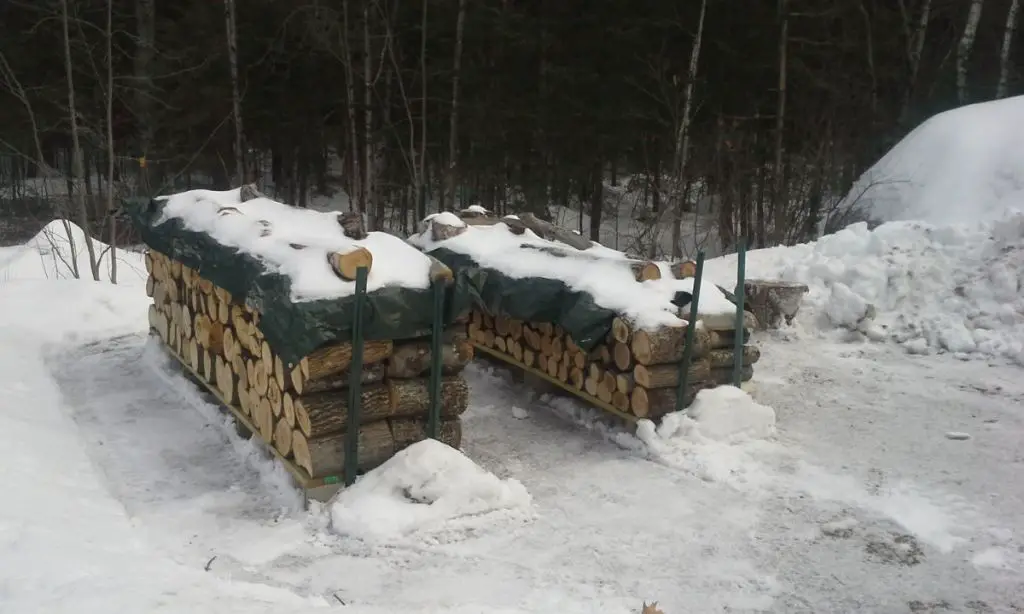What Is Winter Wood?
What is Winter Wood?
Winter wood refers to wood that is cut during the winter months when trees are dormant. The lack of leaves and inactive growth during winter means the tree’s energy is focused inward, resulting in wood that is denser and drier compared to summer wood. This makes winter wood preferable for many applications like furniture, flooring, musical instruments, and firewood.
Winter wood is characterized by narrower annual growth rings and smaller vessels that carry water and nutrients up the tree. With less moisture and slower growth, winter wood is typically harder and stronger than summer wood from the same tree. Diffuse-porous trees like maple and birch show the most significant differences between winter and summer wood.
Why Does Wood Change in Winter?
Wood changes in winter primarily due to the lower temperatures and reduced sap levels. When temperatures drop, the wood loses moisture which causes the wood cells to shrink and contract. According to this source, wood can shrink up to 1% for every 5% change in moisture content. The size and shape of the wood may change slightly as the cells shrink.
In addition, deciduous trees stop producing sap in the winter months when they go dormant. The reduced sap levels allow the wood to further dry out and lose moisture content. Conifers also produce less sap in winter, though they continue to produce some sap year-round. The drier and less saturated the wood becomes, the more the wood cells are able to contract and shrink when exposed to cold temperatures.
The overall effect is that wood becomes more compressed and condensed in the winter months. This can impact the density, hardness, and structural integrity of the wood. According to this source, softwoods like pine are more susceptible to shrinkage from winter weather than hardwoods like oak.
Identifying Winter Wood
Identifying trees in winter when the leaves have fallen can be challenging, but there are a few key characteristics to look for. According to The Ultimate Guide to Winter Tree Identification, the best way to identify trees in winter is by examining the bark, buds, and twig structure.
The bark can provide many clues through its texture, color, and pattern. For example, ash trees have diamond-shaped ridges, while birch trees have papery, peeling bark. The buds also give hints – maple tree buds are often red and pointed, while oak buds tend to be more rounded and clustered. Twig structure provides more clues. Walnut twigs are stout with chambered piths, while cherry twigs are slender with a bitter almond scent when scratched.
The moisture present is another factor. According to Woods in Winter: Reflecting on Winter Tree ID, dead bark on trees like sycamore and dogwood will be wet and slippery, while healthy bark will be dry to the touch. Taking note of these visual and textural clues can help identify trees even without their leaves.
Winter Wood Characteristics
Winter wood refers to wood that is cut during the dormant season, typically from late fall to early spring. The characteristics of winter wood differ from summer wood in a few key ways:
Hardness – Winter wood tends to be harder and denser than summer wood. According to the Mayco Colors, the winter wood has a matte white surface and contains brown crystals.
Strength – The colder temperatures cause the sap to stop flowing in trees during the winter months. This results in a higher concentration of cellulose, making winter wood stronger than summer wood.
Workability – The increased density and hardness of winter wood can make it more difficult to work with. As noted by Northstar Monthly, the structure of the forest emerges more clearly in winter without leaves to obscure it.
Overall, the unique characteristics of winter wood result from physiological changes trees undergo to survive colder temperatures. While harder and stronger, winter wood requires more effort to cut and work with compared to summer wood.
Using Winter Wood
Winter wood has unique properties that make it better suited for some uses compared to wood harvested during other seasons. Some of the best uses for winter wood include:
- Firewood – Winter wood burns hotter and more efficiently than wood cut in spring or summer. The lack of sap and moisture makes it an excellent choice for firewood. Hardwoods like oak and hickory that are cut in winter make ideal firewood.
- Furniture & Woodworking – The dense, dry quality of winter wood makes it perfect for furniture, flooring, and other wood projects. The wood is less likely to warp or crack as it cures.
- Smoking/Grilling – Many pitmasters recommend using winter wood when smoking meat or grilling. Hardwood from oak, hickory, cherry and other trees cut in winter provide a clean, strong smoke flavor.
However, winter wood does come with some limitations and challenges:

- Availability – Finding a ready supply of seasoned winter wood may be difficult in some regions.
- Storage – Keeping the wood dry until needed requires proper storage like a woodshed or covering with a tarp.
- Short Cutting Window – The winter cutting season for hardwoods is relatively short from around December to February.
Overall, winter wood is an excellent resource for a variety of applications when properly harvested, stored, and used.
When to Cut Winter Wood
The ideal time to cut wood for winter use is in late fall or early winter when the trees are dormant. According to experts, the best time is between November and February, after the leaves have fallen and sap levels are lowest (MyOleoMac). Cutting wood at this time allows it to dry out or “season” over the spring and summer months before burning it in winter.
Cutting wood in late fall or winter means the tree has less moisture content from spring growth and sap flow. Wood cut during the dormant season will be drier and therefore burn better with higher heat output. The winter months also allow more time for the wood to cure before you need it for heating purposes. Some pros recommend cutting a little earlier around October for hardwoods like oak so they have extra dry time (Hearth.com).
Storing Winter Wood
Proper storage is critical for seasoning and drying winter wood. Freshly cut winter wood contains a lot of moisture, usually between 30-60% by weight. In order for the wood to burn efficiently, this moisture content needs to be reduced to around 20%.
The key considerations for storing winter wood are ventilation, shelter, and distance from your home. The wood needs to be kept in an open area that allows air flow on all sides to promote drying. A covered area like a woodshed or tarp canopy is ideal to allow ventilation while providing some protection from rain and snow. According to this source, firewood should be stored at least 20-30 feet from your home as a safety precaution.
Splitting the wood exposes more surface area and allows moisture to evaporate more quickly than unsplit rounds. Stacks should be kept off the ground on pallets or rails to avoid drawing moisture up from the soil. The optimal way to season and dry winter wood is to store it split and stacked in an open-aired covered area for 6-12 months before burning.
Winter Wood and Firewood
Winter wood refers to wood that is cut and dried throughout the winter season. As wood dries over the cold winter months, its moisture content drops, making it ideal for burning in fireplaces and wood stoves (https://www.winterwood-farm.com/seasoned-firewood/).
Firewood cut during winter has excellent burn qualities thanks to its low moisture content. Wet wood contains up to 50% moisture while properly seasoned winter wood only contains around 20% moisture. The lower moisture content allows winter wood to burn hotter and produce more BTUs (British Thermal Units) when burned. Seasoned winter wood can provide between 15-20 million BTUs per cord compared to only 5-10 million BTUs for unseasoned “green” wood.
Less moisture also means winter wood burns more efficiently and completely. Wet wood wastes energy evaporating moisture rather than efficiently producing heat. Winter wood burns down to ash rather than leaving behind unburned wood and creosote buildup in chimneys. Overall, winter wood’s excellent burn qualities make it an ideal choice for home heating during the cold winter months.
Regional Differences
Winter wood varies in its characteristics based on tree species and climate. In the southern United States, winter is much milder with shorter periods of cold weather. Trees such as oak, hickory, and pine undergo less drastic changes than trees in northern climates (source).
In the North, species like maple, birch, and ash experience more pronounced changes in the winter months. Their sap stops flowing, moisture content drops, and the wood shrinks and hardens. This makes northern winter wood denser and better for burning as firewood (source). The climate causes more dramatic transformations in cellular structure and chemistry.
Softwoods like pine and fir also undergo winter changes but not to the same degree as hardwoods. Softwoods have more resin and maintain more moisture so the differences between summer and winter wood are less significant.
Overall, the geographic location and specific tree species impact the characteristics and uses of winter wood. Colder northern climates produce harder, denser winter wood than warmer southern regions.
Alternatives to Winter Wood
There are some alternatives to winter wood that have their own pros and cons in comparison. Using other types of wood besides winter wood may be preferred by some for functional or aesthetic reasons.
Some popular alternatives to winter wood include:
- Spring wood – Wood cut in spring has more moisture and is often lighter in color. It doesn’t burn as hot or long, but is easier to cut and split when green.
- Summer wood – Summer wood tends to be dense but burns faster. The high sap content can cause more smoke.
- Fall wood – Fall trees pull nutrients from leaves into wood before winter, making fall wood energy rich. It has average moisture.
- Dry seasoned wood – Letting cut wood dry for 6+ months reduces moisture for better burning. This can be done with any wood.
- Alder – Burns hot and splits easily. Drawbacks are more smoke and sparks.
- Apple – Sweet smelling wood that’s easy to split when seasoned. Doesn’t last as long in a fire.
- Oak – A top choice for firewood due to high heat output and long burn times.
When considering alternatives, the moisture content, density, smell, and availability in your area are all factors. Testing different woods can reveal personal preferences in performance, ease of use, and aesthetics.




